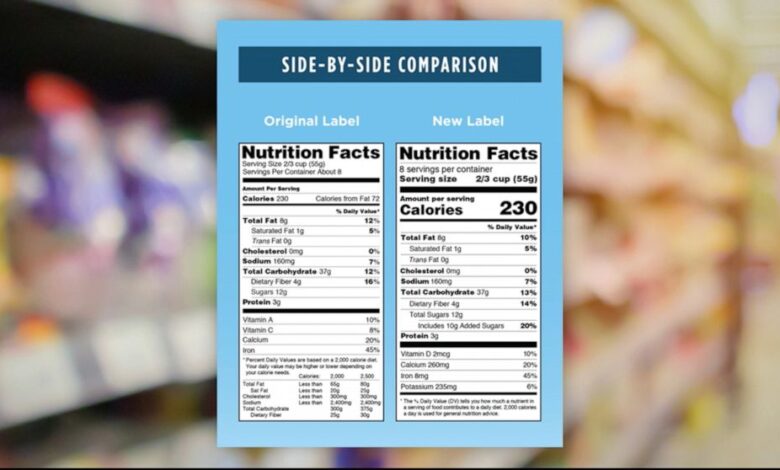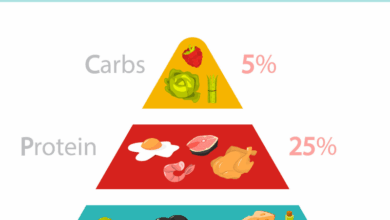
New nutrition labels help you eat less, offering a fresh approach to understanding the nutritional content of food. These updated labels aim to make healthier choices easier by highlighting key information in a more prominent way. The changes go beyond just a visual overhaul; they are designed to encourage conscious consumption and ultimately support healthier eating habits.
This detailed analysis explores the key changes in the new nutrition labels, examining their potential impact on consumer behavior, comparison to existing international standards, accessibility for all demographics, potential pitfalls, visual design, and long-term effects on the food industry. We will delve into how these changes might influence portion sizes, dietary habits, and even global food culture.
Understanding the New Nutrition Labels
The redesigned nutrition labels aim to improve clarity and make it easier for consumers to make healthier food choices. These updates, resulting from years of research and consumer feedback, reflect a shift in how we present nutritional information, with a focus on highlighting key elements that impact health. This is a significant change, and understanding the rationale behind it will help you use the new labels effectively.
Key Changes in the New Labels
The new nutrition labels feature a modernized layout and emphasize key nutrients that impact health. Key changes include a larger font size for calories, updated serving sizes, and the removal of certain elements. These changes are designed to ensure consumers see essential information more quickly and readily. The goal is to help consumers make informed choices by placing crucial information front and center.
Rationale Behind the Design Changes
The rationale behind the design changes stems from extensive research highlighting consumer difficulties with understanding the old labels. Many found the layout confusing and the presentation of information cumbersome. The updated design addresses these issues, focusing on clear, concise information that is easy to interpret. The goal is to create a format that aids consumers in quick assessment of nutritional value and supports healthier choices.
How the Changes Improve Consumer Understanding
The new labels improve consumer understanding by prioritizing key nutritional elements. The updated layout with larger fonts for calories, a prominent daily value section, and simplified information structure directly improves comprehension. This clear presentation will enable consumers to make informed decisions about the nutritional content of the food they consume, and empower them to plan a balanced diet.
This simplified structure and prominent placement of crucial data will contribute to better health choices.
Examples of Differences from Old Labels
The new labels have a more modern look, featuring a bolder font for calories and a simplified layout. The daily values now clearly show the percentage of the daily recommended intake of each nutrient. Furthermore, the new format places calories prominently, making them instantly noticeable. This is a significant shift, improving consumer comprehension. These improvements ensure that consumers have clear and concise information at their fingertips, empowering them to make informed decisions.
Prominence of Key Nutritional Information
The new labels emphasize calories prominently, making them immediately noticeable. Serving sizes are also more clear and upfront, helping consumers understand the nutritional content per portion. This is a significant shift from the old labels, where these key pieces of information were sometimes buried within the text. This prominent placement of key data is a deliberate design decision aimed at increasing user engagement and ease of use.
Comparison of Old and New Formats
| Feature | Old Format | New Format |
|---|---|---|
| Serving Size | Often buried in the text | More prominent and easily visible |
| Calories | Sometimes less noticeable | Large, bold font, top position |
| Daily Values | Hidden within the table | Clear, concise percentage display |
| Layout | Often cluttered | Simplified and easy to navigate |
These changes demonstrate a clear effort to streamline information, making it easier to grasp the nutritional value at a glance. The new format is a direct response to user feedback and research, resulting in a more user-friendly design.
Impact on Consumer Behavior: New Nutrition Labels Help You Eat Less
The revamped nutrition labels are poised to significantly alter consumer interactions with food products. This shift presents both opportunities and challenges, impacting not only purchasing decisions but also deeply ingrained dietary habits and ultimately, health outcomes. Understanding how consumers will react to these changes is crucial for retailers, food manufacturers, and public health initiatives.The new design, with its emphasis on clarity and ease of understanding, aims to empower consumers with the knowledge needed to make informed choices.
However, this change also introduces new variables that might lead to unexpected consequences. Will consumers truly embrace this shift, or will they resist the changes, potentially hindering progress towards a healthier population? Analyzing both the positive and negative impacts is essential to accurately predict the long-term effect on consumer behavior.
Potential Positive Impacts on Consumer Food Choices
The new labels, with their simplified format and prominent placement of key nutrients, can encourage more conscious food choices. Clearer calorie information, displayed more prominently, might motivate consumers to consider portion sizes and make healthier selections. The emphasis on added sugars and saturated fats allows for better comparison shopping, empowering consumers to opt for products with lower amounts of these ingredients.
- Increased Awareness of Nutrient Content: Consumers will likely become more aware of the nutrient content of various food items, leading to more informed choices. This heightened awareness might translate into a preference for foods with a lower calorie, sugar, or fat content. For example, a consumer previously unaware of the sugar content in a certain breakfast cereal might now actively seek out alternatives with less added sugar.
- Improved Comparison Shopping: The new labels, with their standardized format, will allow for easier comparison shopping. Consumers can quickly identify products with lower levels of key nutrients, enabling them to make healthier choices across different brands and types of food.
- Emphasis on Portion Control: The prominent display of calories per serving can directly influence portion sizes. Consumers might consciously adjust their consumption, particularly when faced with higher calorie options. For example, if a restaurant menu clearly displays the calorie count for a meal, customers might choose a smaller portion to control their caloric intake.
Potential Negative Impacts on Consumer Food Choices, New nutrition labels help you eat less
Despite the positive potential, the new labels could also lead to unforeseen negative consequences. The sheer volume of information on the labels might overwhelm some consumers, leading to confusion and potentially less-informed choices. Consumers accustomed to the old format may find the new layout challenging to interpret, hindering their ability to make quick and effective decisions. Some consumers may interpret the data subjectively, potentially leading to a distorted perception of a product’s overall health value.
- Potential for Confusion: The redesigned format, while intended to be clearer, might actually overwhelm some consumers. The sheer amount of information on a single label might lead to confusion and potentially less informed choices. For example, consumers might struggle to interpret the complex interactions between different nutrients presented on the label, leading to suboptimal food selections.
- Loss of Familiarity: Consumers who are accustomed to the old format may find the new layout challenging to interpret. This could lead to a period of adjustment, potentially hindering their ability to make quick and effective decisions in the supermarket. Consumers might inadvertently select products they would otherwise avoid due to their unfamiliarity with the new layout.
- Subjective Interpretations: The interpretation of data on the labels could vary significantly between consumers. A consumer might prioritize different nutrients, leading to a subjective assessment of a product’s overall health value. This could result in consumers selecting products based on individual priorities rather than a comprehensive understanding of their nutritional composition.
Impact on Dietary Habits and Health Outcomes
The changes in nutrition labeling have the potential to significantly influence dietary habits. Positive impacts could include a greater emphasis on portion control and a shift towards healthier food options. Conversely, confusion or overwhelm might lead to consumers making less-than-ideal choices, hindering progress towards healthier dietary habits. The overall effect on health outcomes remains uncertain and depends heavily on consumer reaction.
How the New Layout Could Influence Portion Sizes
The prominent display of calories per serving is likely to influence portion sizes. Consumers, consciously or subconsciously, will likely adjust their consumption based on the calorie information presented. This could lead to a decrease in portion sizes, particularly when consumers are faced with higher-calorie options.
Comparison of Consumer Perceptions of Old and New Labels
| Aspect | Old Labels | New Labels |
|---|---|---|
| Clarity | Often ambiguous, requiring significant interpretation. | Intended to be more straightforward and easier to understand. |
| Emphasis | Focus on specific nutrients might be less clear. | Key nutrients (calories, added sugars, saturated fats) are more prominent. |
| Ease of Comparison | Comparison shopping can be challenging. | Standardized format facilitates easier comparison across products. |
| Consumer Response | Mixed reactions, with some finding them difficult to interpret. | Expected to be more universally understandable, potentially improving consumer confidence in their purchasing decisions. |
Comparison to Existing Standards
The new nutrition labels represent a significant shift in how nutritional information is presented to consumers. Understanding how these labels compare to existing standards, both domestically and internationally, is crucial for assessing their effectiveness and potential impact. A critical evaluation of similarities and differences, strengths and weaknesses, is essential to fully appreciate the design choices behind the new labels.This comparison allows us to analyze whether the new labels represent a global advancement in nutrition communication or a localized approach with limited global applicability.
Understanding the factors driving the design choices sheds light on the intended goals and potential for these labels to encourage healthier food choices globally.
Similarities and Differences Across Countries
Different countries have varying approaches to nutritional labeling, reflecting diverse cultural preferences and regulatory frameworks. While the overarching goal of providing clear and concise information about food products remains consistent, the specific details, such as which nutrients are highlighted, the format of the information, and the level of detail, can differ significantly. The new labels’ alignment with international standards, or deviation from them, will be a key factor in their global adoption and impact.
| Country | Label Format | Key Nutrients Emphasized | Serving Size Specification |
|---|---|---|---|
| United States (Pre-2024) | Columnar format, with larger font for calories | Calories, fat, saturated fat, cholesterol, sodium, carbohydrates, sugar, protein | Typically per serving |
| United States (Post-2024) | Horizontal format, emphasizing daily values | Calories, nutrients, and % Daily Value (DV) | Per serving |
| Canada | Columnar format, similar to the US (pre-2024) | Calories, fat, saturated fat, trans fat, cholesterol, sodium, sugars, carbohydrates, protein | Per serving |
| United Kingdom | Large font for calories, clear presentation of sugars | Calories, fat, saturated fat, sugar, salt | Per 100g or 100ml |
Strengths and Weaknesses of the New Labels
The new labels’ strengths lie in their emphasis on daily values, providing a more comprehensive understanding of a product’s nutritional contribution within a person’s daily diet. The use of % Daily Value (DV) is a significant improvement, allowing consumers to make more informed choices about the overall nutrient content of a food item in the context of their daily intake.However, the new labels also present some weaknesses.
The horizontal format, while visually appealing, might be less intuitive for some consumers accustomed to the columnar format. The potential for misinterpretation of the % Daily Value (DV) in relation to specific health needs also requires careful consideration and consumer education.
Key Factors Driving Design Choices
Several factors influenced the design choices for the new labels. The desire to enhance consumer understanding and encourage healthier dietary habits was a key driver. Another factor was the need to align with international standards, while also reflecting the specific nutritional needs and preferences of the American population. The use of a simpler, more visually appealing design, as well as highlighting key nutrients like added sugars, are also key factors.
Potential for Fostering a Healthier Global Food Culture
The new labels, if adopted globally with similar approaches, could foster a healthier global food culture. The standardized approach could make it easier for consumers worldwide to compare food products and make informed choices. This consistency, coupled with a focus on daily values and easily digestible information, could empower consumers to make healthier decisions regardless of their location.
Accessibility and Interpretation

New nutrition labels, while aiming to improve public health, must be accessible to all. This crucial aspect extends beyond simply providing accurate information; it involves ensuring the information is comprehensible to diverse populations. Failure to consider accessibility could inadvertently widen health disparities, defeating the very purpose of the label updates.
Potential Challenges for Specific Demographics
Interpreting complex information, like nutrition labels, can be a significant hurdle for certain demographics. Limited literacy, cultural differences in understanding food terms, and varying levels of numeracy can create barriers. Older adults, low-income populations, and individuals with disabilities might find it more difficult to decipher the new labeling compared to others. Language barriers also present a challenge, requiring multilingual options and potentially simpler explanations.
New nutrition labels are a game-changer for mindful eating, making it easier to track calories and portion sizes. It’s all about making healthier choices, and it’s great for everyone! But amidst the new food labels, don’t forget to check in on your new mom friends – they’re likely juggling a lot more than just the latest food pyramid.
Remember, new moms need extra support, just like those new labels help us make healthier choices. Knowing they have a supportive network can make all the difference, and that’s why you should check on your new mom friends. why you should check on your new mom friends Ultimately, taking a mindful approach to food, and supporting the people in our lives, is key to a healthier, happier life.
Importance of Clear and Concise Labeling
Clear and concise labeling is paramount for all consumers. Complex or overly technical language can confuse even those with a good understanding of nutrition. The design should prioritize visual clarity and ease of understanding. Using large, easy-to-read fonts, high-contrast colors, and simplified graphics can significantly improve accessibility. This includes employing clear and straightforward language, avoiding jargon, and employing concise phrasing.
Strategies for Enhanced Accessibility
To improve accessibility for individuals with limited literacy or understanding, several strategies can be implemented. These include providing simplified versions of the labels, employing interactive elements, and offering tailored educational materials. Providing multiple languages on the labels is crucial, especially for communities with limited English proficiency. Consideration should be given to alternative formats, such as large-print versions and audio descriptions.
Clear and concise icons or symbols that can convey key information visually can aid understanding.
Role of Technology in Aiding Label Interpretation
Technology offers valuable tools for improving accessibility. Mobile apps and websites dedicated to interpreting nutrition labels can provide real-time translations, calculations, and personalized recommendations. These digital resources can assist users in understanding the information more effectively. Voice-activated apps can also translate the labels for users with visual impairments or reading difficulties.
Example Improvements in Label Design
A good example of improving label design is using larger font sizes and contrasting colors for key information, like calories and serving sizes. Icons or symbols, along with concise explanations, can enhance understanding. The use of interactive elements, like pop-up windows or tooltips, can provide additional information on demand. Using simple color-coding for different nutritional elements, such as green for healthy fats and red for high sodium, can also help.
Table Outlining Approaches to Label Accessibility
| Approach | Description | Example |
|---|---|---|
| Simplified Label Versions | Creating easier-to-understand versions for specific demographics | A basic label for older adults with larger font sizes and simplified nutritional information. |
| Interactive Elements | Adding interactive elements, such as pop-up explanations | A clickable calorie breakdown or a button for comparing similar products. |
| Multilingual Options | Providing labels in multiple languages | Offering the label in Spanish, French, and Mandarin, alongside English. |
| Large Print/Audio Descriptions | Offering alternative formats for individuals with visual impairments | A large-print version of the label or an audio description for visually impaired consumers. |
| Educational Materials | Creating pamphlets or online resources for better understanding | A guide on how to interpret the new nutrition labels, accessible online and in local community centers. |
Potential for Misinterpretation
The new nutrition labels represent a significant step forward in helping consumers make informed food choices. However, the potential for misinterpretation exists, and it’s crucial to anticipate and address these possibilities. A poorly designed label can easily confuse consumers, leading to inaccurate assessments of a product’s nutritional value. Therefore, meticulous attention to clarity and accuracy is paramount in the label’s design and implementation.The complexity of modern food processing and ingredients can lead to nuanced interpretations.
Consumers, while striving to make healthy choices, may misinterpret the presented information if the layout or wording is not straightforward and accessible. The design must prioritize clear communication over intricate details, focusing on conveying essential nutritional information in a manner that is readily understood.
Potential Scenarios for Misinterpretation
Misinterpretations can arise from various factors. A crucial aspect is the relative prominence of different nutritional components. If the information about added sugars, for instance, is not presented prominently enough in relation to other nutrients, consumers might overlook its impact on the overall nutritional profile. The use of unfamiliar terminology or technical jargon can also create confusion.
The label must employ plain language and avoid industry-specific terms. Consumers need to grasp the information without needing to consult a nutritionist.
New nutrition labels are finally making a difference in helping us eat healthier! It’s amazing how much more mindful you can become of your choices. To really boost your healthy habits, a quick 10 minute morning workout like this one 10 minute morning workout can help you feel great and make healthier food choices stick. This combination of conscious eating and a little daily exercise is a powerful way to make a lasting impact on your overall well-being, further emphasizing how helpful these new labels are.
Pitfalls in Label Design and Presentation
The presentation of the label is crucial. A cluttered or visually overwhelming design can impede comprehension. Color schemes, font sizes, and the arrangement of data all play a significant role in the overall impact. The label should be aesthetically pleasing and easy to read. If the format isn’t conducive to quick and easy understanding, the intended purpose of providing clarity is lost.
For example, if the serving size is unusually large, consumers may unintentionally overestimate the amount of calories or nutrients they’re consuming. Likewise, small print or complex formatting can hinder comprehension, especially for individuals with visual impairments.
Importance of Clear and Accurate Information
Accurate and clear information is essential to prevent misinterpretation. The labels should provide complete and unbiased information, allowing consumers to make well-informed choices. The data should not be misleading or subject to ambiguity. Any ambiguity can lead to incorrect conclusions, thereby defeating the purpose of the label.
Examples of Misunderstanding
Consider a food product with a high amount of fiber but also a significant amount of added sugars. If the label doesn’t clearly highlight the presence and amount of added sugars, consumers might mistakenly believe the product is a healthy choice due to its high fiber content. A similar scenario arises when the serving size is not clearly defined.
A product labeled with a low sodium content but a large serving size can be misleading. Consumers might underestimate the total sodium intake if they don’t pay close attention to the serving size.
New nutrition labels are a game-changer for mindful eating, helping us make healthier choices. While the science behind these labels is fascinating, it’s interesting to note that some research suggests a possible connection between certain viruses, like herpes, and cognitive decline, potentially linked to dementia. This research, like studies exploring the evidence of link between herpes and dementia , highlights the complex interplay of factors impacting our well-being, ultimately reminding us of the importance of a balanced diet in maintaining overall health.
In the end, though, those new nutrition labels are still a great way to cut back on unnecessary calories.
Misleading Information
Misleading information can arise from using misleading units or percentages. If the percentage of daily value for a particular nutrient is extremely high, consumers might assume it’s an excellent source of that nutrient without understanding the context of the overall diet. Presenting percentages without clearly stating the recommended daily intake can lead to misinterpretations. A label should always include the actual amount of the nutrient in a single serving.
Table of Potential Misunderstandings and Prevention Strategies
| Potential Misunderstanding | Prevention Strategy |
|---|---|
| Overlooking added sugars due to prominence of other nutrients. | Highlight added sugars prominently and use clear language to explain their impact. |
| Confusion due to unfamiliar terminology. | Use plain language and provide clear definitions for any technical terms. |
| Misunderstanding serving size and portion sizes. | Clearly define serving size and use visual cues (e.g., image of a serving) to aid understanding. |
| Incorrect estimation of nutrient intake due to confusing label design. | Employ a simple, uncluttered design, using appropriate font sizes and colors. |
| Misinterpreting percentage daily values without understanding the context of daily intake. | Clearly state the recommended daily intake and provide a clear explanation of what constitutes a “high” or “low” percentage. |
Visual Design and Impact
The visual design of nutrition labels plays a crucial role in how consumers perceive and interact with the information presented. A well-designed label can effectively communicate key nutritional aspects, encouraging healthier choices, while a poorly designed one might deter engagement and potentially mislead consumers. This section will delve into the impact of visual design elements on consumer behavior, highlighting effective strategies and areas for improvement.
Impact on Consumer Engagement
Effective nutrition labels are more than just a collection of numbers; they are a visual experience. The design should capture attention and guide the eye to the most important information. A visually engaging label fosters curiosity and encourages deeper exploration of the nutritional content, potentially leading to more informed purchasing decisions. Conversely, a confusing or unappealing design can discourage reading and result in consumers making less healthy choices.
Clear and concise visual communication is key.
Design Elements for Clear and Engaging Labels
Several design elements contribute to the clarity and engagement of nutrition labels. Color palettes, font choices, and layout are critical in creating a visual hierarchy that highlights key information. The use of contrasting colors can draw attention to important values like high or low nutrient content, making the label more impactful. Font sizes and styles are crucial for readability, ensuring that all details are easily accessible and comprehensible.
A well-structured layout, including clear spacing and logical grouping of information, promotes a smooth reading experience, further enhancing understanding.
Color, Font, and Layout Affecting Perceived Healthiness
Color psychology plays a significant role in how consumers perceive the healthiness of a product. Warm colors, such as reds and oranges, are often associated with energy and excitement, potentially making a product appear less healthy. Cooler colors, like blues and greens, often evoke feelings of calmness and health, which could positively influence consumer perceptions. Font choices also contribute; a clean, modern font can convey a sense of health and quality, whereas a cluttered or ornate font might suggest a less healthy option.
Layout, including the visual hierarchy and placement of elements, is vital in directing the consumer’s focus.
Psychology Behind Effective Visual Design
The psychology behind effective visual design for nutrition labels involves understanding how humans perceive and process information visually. Visual cues like color and contrast can influence the way information is interpreted. Effective labels leverage the principles of visual hierarchy to guide the consumer’s eye towards critical information. For instance, a prominent display of low-fat or high-fiber content can trigger a more positive perception.
This knowledge allows designers to craft labels that resonate with consumer psychology and encourage healthy choices.
Elements for Improvement in Visual Appeal and Clarity
While current labels often meet basic requirements, areas for improvement exist in terms of visual appeal and clarity. One area is the consistency of color coding across different categories of nutrients. Another area is streamlining the overall layout to avoid clutter and improve readability. Utilizing icons or symbols to represent nutritional values can enhance understanding and engagement, especially for consumers with varying literacy levels.
Example Label Designs
| Label Design | Color Palette | Font | Layout |
|---|---|---|---|
| Design A | Muted blues and greens | Sans-serif, bold | Clear visual hierarchy, prominent nutritional information |
| Design B | Vibrant oranges and yellows | Serif, italic | Less structured, emphasizes product appeal |
| Design C | Contrasting black and white with accents | Sans-serif, bold | Modern, high-contrast design |
These examples illustrate different approaches to label design. The best design would likely be a hybrid approach, combining the strengths of each while focusing on clear and accessible presentation of key nutritional information.
Long-Term Effects on Food Industry

The rollout of new nutrition labels represents a significant shift in how consumers interact with food products. This evolution forces a profound recalibration within the food industry, impacting everything from product development to marketing strategies. Manufacturers must adapt to these changes to maintain competitiveness and consumer trust.The new nutrition labels are not simply a cosmetic update; they represent a fundamental shift in how consumers perceive and choose food.
This shift will undeniably reshape the food industry’s landscape, pushing manufacturers to innovate and adapt to the changing demands of the market.
Influence on Food Industry Practices
The new nutrition labels will fundamentally alter how food manufacturers approach product development and formulation. Manufacturers will be compelled to scrutinize their current ingredients and processes, potentially leading to adjustments in ingredient sourcing and manufacturing techniques. This is not a short-term trend; rather, it represents a long-term shift in the industry’s focus on health and well-being.
Potential for Manufacturers to Adjust Product Formulations
Manufacturers will likely prioritize reformulating existing products to meet the new criteria for nutrient content and labeling. This might involve reducing added sugars, sodium, or unhealthy fats. For example, companies might swap high-fructose corn syrup for natural sweeteners or utilize leaner protein sources. Companies may also invest in novel technologies to achieve desired nutritional profiles, such as developing healthier substitutes for traditional ingredients.
These adjustments will not always be straightforward, requiring careful consideration of taste, texture, and overall consumer acceptance.
Impact on Marketing Strategies for Food Products
The new labeling requirements will necessitate adjustments to marketing strategies. Food manufacturers will need to highlight the nutritional benefits of their products more prominently, emphasizing the positive aspects of the updated labeling. For example, if a product has a reduced sugar content, the marketing materials should clearly communicate this change. Highlighting the health benefits associated with the new product formulations will be critical in attracting consumers and building brand loyalty.
Examples of How Manufacturers Might Respond to the Changes
Numerous strategies are likely to emerge in response to these changes. One response will be to focus on transparency. This will involve providing clear and concise information about the nutritional value of their products, addressing concerns about ingredients and processes, and showcasing commitment to health and well-being. Another response will involve creating entirely new product lines that explicitly adhere to the new labeling guidelines, thus catering to the growing demand for healthier options.
- Ingredient Substitution: Companies might switch to healthier alternatives for ingredients like sugar or fat.
- Product Reformulation: Existing products will be re-formulated to meet the new guidelines, potentially altering taste and texture.
- New Product Development: Companies might introduce entirely new products designed specifically to meet the new nutritional guidelines.
Potential Strategies to Improve Transparency and Consumer Trust
To maintain consumer trust, manufacturers will need to emphasize transparency in their labeling and sourcing practices. This involves clearly communicating the origin and processing of ingredients. Detailed information about nutritional value and any alterations made to products will be crucial. This enhanced transparency can build trust and potentially create a more positive brand image. Furthermore, open communication with consumers regarding the reasons behind changes in products will be key to building long-term loyalty.
- Clear Labeling: Providing clear, comprehensive labeling that meets all new standards will be vital.
- Open Communication: Honest communication with consumers about ingredient choices and changes to formulations will foster trust.
- Independent Verification: Utilizing independent verification of nutritional content can enhance consumer confidence.
Potential Changes in Food Product Labeling and Marketing
| Aspect | Current Practice | Potential Future Practice |
|---|---|---|
| Nutritional Information | Basic nutrient breakdown | Detailed breakdown, highlighting key nutrients and specific portions of the product |
| Marketing Focus | Highlighting taste and convenience | Highlighting nutritional benefits and health attributes |
| Ingredient Transparency | Limited details | Comprehensive information about ingredients, sourcing, and processing |
Final Review
In conclusion, the new nutrition labels represent a significant step towards improved consumer understanding and healthier eating choices. While challenges in interpretation and potential misinterpretations exist, the overall goal of these changes is clear: to empower consumers with the knowledge they need to make informed decisions about the food they consume. The future success of these labels hinges on ongoing feedback, clear communication, and continuous efforts to ensure their accessibility and effectiveness across diverse populations.





